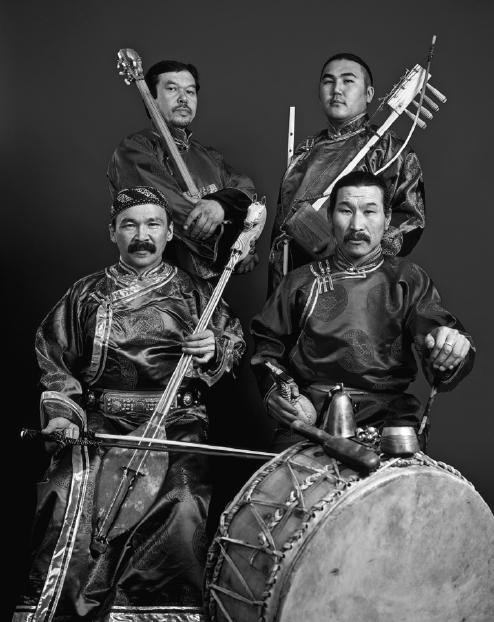Sunbeams from the north
Popular throat singing musicians from the Tuva Republic make return to China with five-city tour, Chen Nan reports.

If you journey to the Tuva Republic in the Russian Federation, you will reach the home of Huun Huur Tu, a group of fascinating khoomei singers dedicated to performing old and forgotten songs with traditional and contemporary musical instruments.
The quartet, which made its debut in China back in 2008, gained a large fan base after embarking on its first major tour in the country in 2014.
This September, the group will return with a tour of Chinese cities — Beijing, Suzhou in Jiangsu province, Shenzhen in Guangdong province and Shanghai — from Sept 21 to 27, featuring songs, such as Ancestors, The Orphan's Lament and Remembering Ulaatai River.
They will also perform on the opening day of the outdoor Central China Midi Festival, which will take place from Sept 29 to Oct 2 at a resort in Nanyang city, Henan province, located between Dushan Mountain and Baihe River.
"It has been four years since we last performed in China. We will perform some of our favorite songs. We have many great memories of performing in China and, hopefully, the songs will ignite the memories of the audiences," says Sayan Bapa, a member of Huun Huur Tu.
"Since we all live deep in the forest, we dedicate those songs to the beauty of nature and the people who were born, raised and still live there," Bapa says, adding that, with lyrics translated and displayed as subtitles during their concerts, Chinese audiences will be able to understand what the songs are about and learn about the history and culture of their home country.
He recalls that when they first performed in China, some people might have had no idea what they were doing, but the feedback was great, which made the members of the band very happy.
"For those who have never been to our concerts, I think their ears, eyes and minds will be surprised," Bapa says. "People told us that they enjoy our music, just like they enjoy nature, the fresh air and clean water."
The quartet, made up of singers and musicians Sayan Bapa, Kaigal-ool Khovalyg, Radik Tyulyush and Alexey Saryglar, was founded in 1992. Some of them are old friends and have played music together since the 1970s.
Huun Huur Tu means "sunshine" or "sunbeams" in Tuvan. It also refers to the vertical separation of light rays that can often be seen out on the grasslands just after sunrise or just before sunset.
All of the members sing, both as soloists and together, as well as playing traditional Tuvan instruments, including Bapa's three-stringed doshpuluur (Tuvan lute), Tyulyush's four-stringed byzaanchi (four-string fiddle) and flutelike instrument shoor, Khovalyg's two-stringed bowed igil and Saryglar's shaman drum.
Khoomei is an old technique also known as throat singing, which allows singers to produce the sounds of multiple notes simultaneously in their throat. Khoomei was inscribed on the UNESCO Representative List of the Intangible Cultural Heritage of Humanity in 2009.Other than Tuva, it is also practiced in North China's Inner Mongolia autonomous region and Mongolia.
Huun Huur Tu's distinctive style once expanded Western conceptions of the capabilities of the human voice. With each album they released and each show they gave during the past three decades, the quartet has shown that khoomei is not just an exotic novelty, but a part of a rich tradition of their culture.
Nobel Prize winner in physics Richard Feynman, who dreamed about going to Tuva, gave ethnomusicologist Ted Levin recordings of khoomei by Tuvan musicians, according to Bapa. Overwhelmed by the mysterious sound, in 1987, Levin traveled to the country, where he met the four musicians of Huun Huur Tu.
In 1993, Huun Huur Tu released its first album, 60 Horses in My Herd and the same year, the band made its American debut, enabling the members to become musical ambassadors of Tuva.
Though rooted deeply in the traditional music and culture of Tuva, the quartet is known for innovation, transforming ancient songs into complex acoustic compositions. While touring around the world, the band has worked with musicians across genres, such as collaborations with American string quartet Kronos Quartet in 1997, and creating a dance remix of their track Far Away From Home from the group's album Spirits From Tuva, in 2003.
"It's important for us to find new energy for our music, so we have been collaborating with different musicians from jazz to other contemporary music genres. The key to collaboration is to understand each other," Bapa says. "We're trying to preserve our musical heritage but at the same time we're trying to look forward."
"Their sounds are both traditional and international. I've been listening to their songs for many years, and I am still amazed and inspired," said Chinese film director Uragshaa in an early interview. Uragshaa invited Huun Huur Tu to perform in Beijing in 2018 as part of the nonprofit project, Nomad Relays, which he co-launched to celebrate nomadic culture.
According to Liu Zhao, Huun Huur Tu's China tour promoter, and founder-owner of Beijing-headquartered company, Stallion Era Cultural Communication, many Chinese bands have been influenced by Huun Huur Tu's music, especially those dedicated to combining old songs with contemporary musical elements.
"Wherever they (Huun Huur Tu) perform, either outdoors or indoors, they have the magic to transport their audience to the natural wilderness," says Liu. "Some of their songs evoke a state of tranquility and calmness. When they perform those songs, the concert halls can sometimes become so quiet that you could hear a pin drop. You can also expect to enjoy rousing tunes, which get your blood pumping."



Today's Top News
- China urges the US to cease provocative actions
- Hope, skepticism and questions ahead of Trump-Putin summit
- Xi's article on promoting healthy, high-quality development of private sector to be published
- China's top diplomat urges Japan to learn from its warring past
- China-built roads bring real benefits to Pacific region
- Japan must face up to its wartime past






























